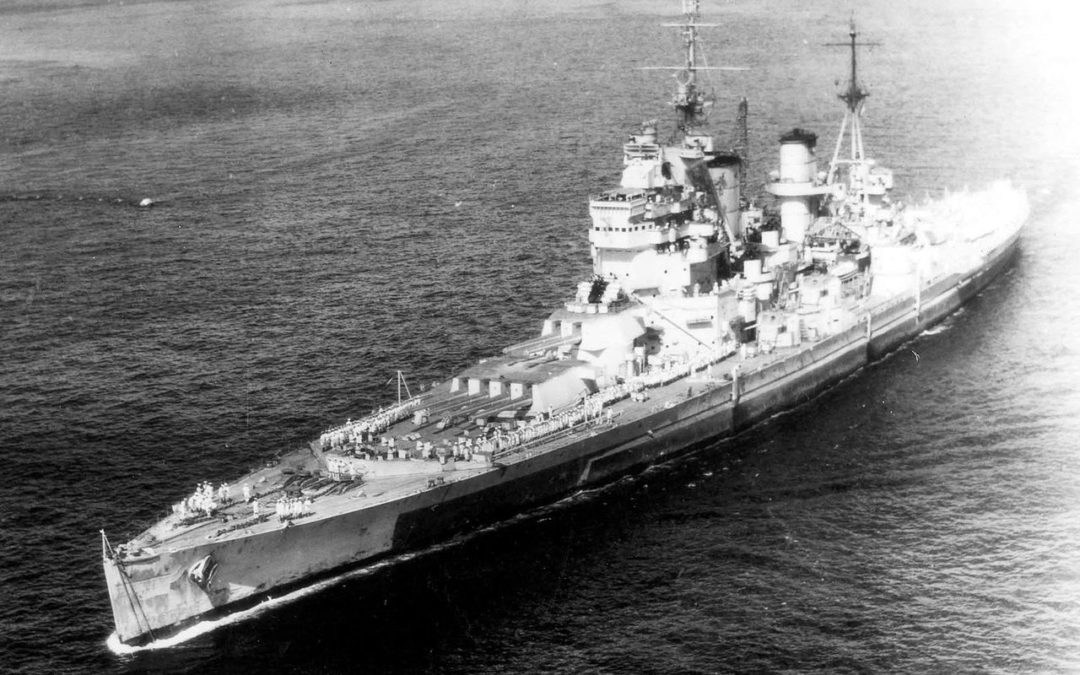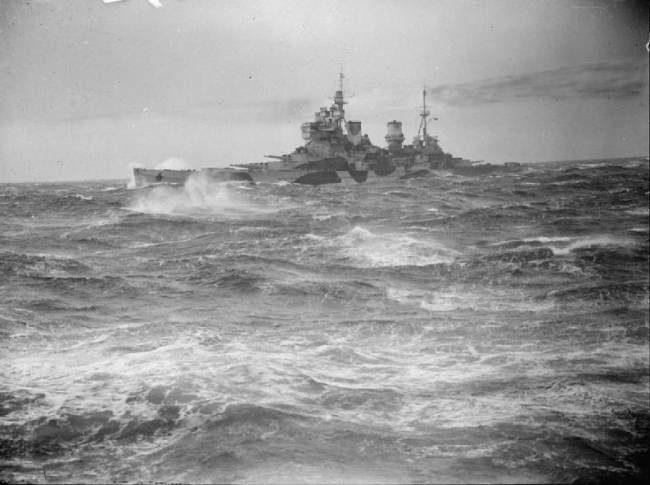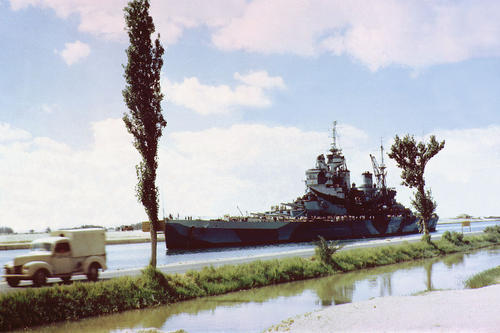Britain’s King George V’s, the only new battleship class they completed for the Second World War, were criticised for shortcomings while being developed, and have often been since portrayed as the least of that war’s new-generation battleships. Winston Churchill, particularly, was loud in his complaints about their relatively small-calibre main armament. And on paper, their Mk VII 14-inch guns, firing a 1590 lb shell,[1] made the King George V’s among the least powerfully armed new battleships of the day. There were also numerous detail design and engineering issues that likely contributed to the loss of HMS Prince of Wales, although – as various analysts have shown, these were not the only factors.[2]
HMS King George V. Drawing by Bombhead, via Shipbucket, Creative Commons Attribution-NonCommercial 4.0 International License.
However, to claim that they were the worst of all the Second World War battleship generation does them an injustice. Of the five built one, Prince of Wales, was lost; but the surviving ships did everything the Royal Navy asked of them. The design was not perfect, but they were better than history has sometimes credited. What’s often forgotten is that these ships were built to a specific set of parameters – constrained not just by international treaty but also by engineering, resource and infrastructure limitations in Britain. The design that emerged was nonetheless adequately armed for purpose and had a good immunity zone against heavier guns than its own main battery, an advantage few battleships of the era enjoyed. The class also had a good turn of speed by Treaty battleship standards. On trials in 1940, King George V exceeded design horsepower and – despite streaming paravanes as a protection against mines – reached 28 knots. This, the Admiralty calculated, was equivalent to 28.75 knots without paravanes. [3] In short, the successive Directors of Naval Construction, Sir Stanley Goodall and Sir Arthur Johns, along with their teams – notably the battleship expert, H. S. Pengelly – knew what they were doing. In service, many of the detail issues were also either correctable or manageable. Nor were those problems necessarily worse than the issues other navies faced with their new ships, such as the problems the Germans suffered with their high-performance boilers; or the vibrations experienced early on in the US Navy’s North Carolina class when they ran their engines up to full power. Why did the British ships get such bad rap? One reason, aside from the repute of their armament, is that the King George V class were thrown into war directly, without a chance for peacetime experience to uncover any engineering issues and correct them. Worse, the earlier ships of the class were committed to combat faster – thanks to Britain’s situation in 1940-41 – than other nations’ equivalent battleships. Then they were worked fairly hard. Inevitably, that was going to emphasise problems.
Detail of the 5.25-inch DP guns fitted to HMS King George V, also intended for the Lions and Vanguard. They were also fitted to a series of anti-aircraft cruisers produced in two sub-classes. Public domain, via Wikipedia.
The overall thinking behind the King George V drew from First World War experience and practical post-war firing tests on full-scale sections of ship structure and the German battleship Baden,[4] further evolved via the G3 and N3 designs drawn up in 1920-21, the Nelson class, and ongoing sketch designs and thinking during the 1920s and early 1930s. The main limitation was financial and industrial, which contributed both to the ‘Treaty’ limits around which the King George V was designed, and to the constraints that guided the details of her armament. After the First World War, Britain faced financial constraints and – at the urging of The Treasury – took the lead in extending the naval limitation system founded in the ‘Washington Treaty’ of 1922. One outcome was the London Naval Treaty of 1930. That was due to expire in 1936; but amidst a western economic depression of unprecedented depth it was May 1934 before the British government agreed to Admiralty demands for a new battleship programme.[5] The pressure was still on to cut scale: but British diplomatic initiatives from late 1935 to reduce battleships to less than 35,000 tons standard were rebuffed,[6] although they did get US agreement to limit main armament to 14-inch guns. However, Japan pulled out; and the upshot was that the Second London Naval Treaty was signed in March 1936 by the US, Britain and France only, with Germany coat-tailing on the terms. The new arrangement also contained an ‘escalator clause’ by which gun calibre could return to 16-inch if Japan or Italy failed to ratify the new arrangement after 1 April 1937.[7] This clause, it is worth noting, related to gun calibre only – not displacement. Japan was not expected to ratify, but diplomacy and international law demanded that the signatories wait until the deadline.[8] That posed timing problems for Britain. Work had been under way for some time on the King George V design, with the aim of laying ships down in the 1936 programme.[9] Although the DNC’s early plans for the new battleships explored 15-inch armament,[10] the 14-inch limit was anticipated and by August 1935 draft designs featured those weapons.[11] The problem was fitting that armament, speed, protection, range and desired sea-going characteristics into the displacement limit. Parameters included optimising the ship for expected battle ranges of 12-16,000 yards.[12]
HMS Howe, of the King George V class, in the Atlantic 1942-43. Public domain.
By early March 1936 the design iterations were up to 14-0, which was 450 tons over the treaty limit and featured a dozen 14-inch guns in three quad mountings.[13] Curiously, US designers on the other side of the Atlantic had come up with the same arrangement for their equivalent, the North Carolina. The ‘escalator’ clause now intruded. It was clear Japan would not ratify the treaty, but both Britain and the US needed to get their new ships started. Technically, it was possible to design a capacity by which quad 14-inch mounts could be swapped for triple 16-inch mountings during construction. However, doing so forced certain compromises if displacement was to be kept within the limit. US naval planners accepted those for their North Carolina class, which were up-gunned to 16-inch.[14] The British were not prepared to make compromises on the King George V because they would have to drop other characteristics.[15] The Board of Admiralty then decided to increase the armour and anti-torpedo protection. This improved the immunity zone against 16-inch fire; over-magazine deck protection was now thought good against the 16-inch 2,375 lb shells being prepared for the Lion class, at 30,625 yards.[16] However, two guns had to be dropped from the main armament and freeboard reduced, among other alterations.[17] The fact that this required designs for a new twin mounting had to be accepted, along with the fact that reduced freeboard was going to worsen the problem of wetness forward; the ships had only five feet of sheer to meet the Board requirement for zero-elevation ahead fire from A turret. This issue underscored the way ship characteristics were closely entwined. The limiting factor for bow flare was actually the weight and structure associated with B-turret, which had to superfire over A.[18] If A-turret was raised to clear a properly flared bow, B-turret would have to be even higher, increasing the weight of the support structures – and that could not be achieved within the treaty displacement limit. That sort of compromise was not the only way in which the British had to peg back from desirable characteristics. Even the metal used for construction was a compromise. Financial constraints prevented the British using high-tensile armour steel – ‘Ducol’ or ‘D’ steel in Admiralty parlance – as extensively as they wanted, although it was used in key structures such as the torpedo defence system.[19]
HMS Duke of York showing how the lack of bow flare caused problems even in moderate seas.
Another issue flowed from a 1936 decision to cut fuel capacity from 4000 to 3700 tons.[20] At the time this was not thought likely to affect range. In fact, the ships were not efficient steamers; when King George V was operating with USS Washington in 1942, the US ship consistently burned far less fuel. The other problem was that the British had invented an anti-torpedo system that involved liquid-loaded compartments. In King George V, these compartments doubled as fuel tanks. They had to be kept full in order to make the anti-torpedo system effective, but in theory, it was possible to allow sea-water to enter from the bottom as fuel was pumped from the top. The components were – theoretically – isolated by a layer of detergent. The practical problem was that under normal ship movement the boundary produced an emulsion layer, there was admixing of the oil and salt water anyway, and the only way to stop all that from clogging the feed systems and causing the superheaters to fail was to stop drawing from the tank early.[21] In the end, some of the double-bottom spaces had to be converted to fuel oil tanks, cutting the effectiveness of the under-bottom protection.[22] Winston Churchill was loud in his criticism, even claiming the ships were weakly armoured amidships and vulnerable because of their aircraft hangars.[23] This was untrue, and was debunked at the time by the First Sea Lord; the ships actually had better protection over the machinery than the Nelsons.[24] However, the idea has surfaced since in enthusiast circles as if true. The main criticism, then and since, has always been the scale of the main armament. The Admiralty was under pressure to get two battleships laid down before 1 January 1937. Because the Japanese would not confirm withdrawal from the treaty before 1 April,[25] the British had no option but to proceed with the 14-inch design. This was accepted, however, because it meant ships were at least being built; and in mid-1936 the Admiralty believed they would only be building two of them. The three battleships authorised for the 1937 building programme were going to have 16-inch guns. However, these weapons had to be ordered by late 1936, and there was a lack of skilled draftsmen to draw up designs.[26] The outcome was that the Admiralty then had to order three repeat King George V’s in 1937, largely because drawings for the 14-inch mountings were available within the time-frame. The 16-inch ships had to wait for 1938, as we shall see in the next article.
HMS Howe passing through the Suez Canal in 1944 en route to the British Pacific Fleet. Public domain.
For all that, when war came the King George V’s did all that was asked of them militarily, once the teething problems had been resolved. The main early problem was that the structures supporting the revolving part of the quad mountings flexed as the hull worked in heavy sea conditions, stopping the turrets from training; and the mechanical tolerances on the ammunition hoists – deliberately designed to be tight as a flash precaution – were over-tight, resulting in jams. Issues of one kind or another were characteristic of any new design: the preceding Nelson class had their own share on completion in the late 1920s. What brought the King George V’s issues into stark relief was the fact that the ships were immediately thrown into war, without a period in which to analyse and resolve mechanical matters. The larger issues with the main armament were, eventually, corrected. Further, despite being criticised for their size, the 14-inch guns did not fall short in service. When King George V joined Rodney in the final cannonade against Bismarck, her 14-inch shells were observed to be effective alongside Rodney’s in destroying the fighting capacity of the German battleship.[27] Naval analyst Norman Friedman has also suggested that, at longer ranges, neither Bismarck nor Tirpitz’ armour, which was optimised for short-range engagement, would have stood up well to British fire.[28] That was never tested in reality; however, the fact remains that when Duke of York took on Scharnhorst at the end of 1943, it was a one-horse race in which the British battleship’s radar fire-control proved its worth,[29] and where her 14-inch shells penetrated Scharnhorst’s armour, disabling her propulsion machinery.[30] This same armament was also capable in other roles. When King George V was bombarding targets on Honshu in July 1945 those guns were as effective on ground targets as any other. It was the last time she was in action, and the last time any British battleship fired its guns at an enemy.[31]
These results speak for themselves. For more on naval history, check out my book The Battlecruiser New Zealand: a Gift to Empire. Click to buy.
More Articles by Matthew Wright: Who won the Battle of Jutland Why were so many warships never built? U-boat attack in strange waters
Copyright © Matthew Wright 2018
Notes [1] http://www.navweaps.com/Weapons/WNBR_14-45_mk7.php, accessed 25 August 2018. [2] Not discussed in this article, but see, e.g. William H. Garzke and Robert O. Dulin, Battleships: British, Soviet, French and Dutch Battleships of World War II, Jane’s Publishing Company, London, pp 195-208 (hereafter ‘Garzke and Dulin’) [3] Norman Friedman, The British Battleship 1906-46, Seaforth, Barnsley, 2015, p. 313. [4] Specifically, the ‘Job 74’ experiments, see Garzke and Dulin p. 231. [5] Friedman, p. 294. [6] Detailed in ibid, pp. 294-295. [7] Naval Limitation Treaty (Second London Naval Treaty) of 25 March 1936, Part 2 Article 4 (2), text at https://www.loc.gov/law/help/us-treaties/bevans/m-ust000003-0257.pdf. [8] Discussed in Friedman, The British Battleship 1906-46, pp. 324-325. [9] Garzke and Dulin, pp. 170-174. [10] Ibid, p. 170 [11] Ibid, p. 171. [12] Ibid, p. 173. [13] Ibid, p. 172. [14] William H. Garzke and R. O. Dulin, Battleships: United States Battleships of World War II, Macdonald and Janes, London, 1976, p. 34. [15] Garzke and Dulin, British, Soviet, French and Dutch battleships of World War II, p. 176. [16] Ibid, p. 231. [17] Ibid, p. 175. [18] Ibid, p. 175. [19] Ibid, p. 234. [20] Friedman, pp. 316-317. [21] Garzke and Dulin, p. 240. [22] Garzke and Dulin, pp 339-340. [23] Winston Churchill, The Second World War, III, The Grand Alliance, p. 781. [24] Ibid. [25] Discussed in Friedman, The British Battleship 1906-46, pp. 324-325. [26] Garzke and Dulin, pp. 176-177. [27] For list of known hits, see William H. Garzke and Robert O. Dulin, Battleships: Axis and Neutral Battleships in World War II, Jane’s, London 1986, pp. 240-241. [28] Friedman, p. 319. [29] Noting that Scharnhorst’s search radar was damaged. Ibid, pp. 165-176. [30] Friedman, p. 319. [31] Garzke and Dulin, British, Soviet, French and Dutch battleships of World War II, p. 215.








Recent Comments